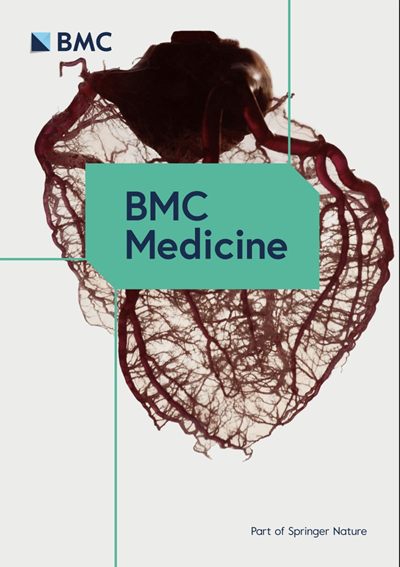睡眠模式、体育锻炼、遗传易感性与类风湿关节炎的发病:一项前瞻性队列研究
IF 7
1区 医学
Q1 MEDICINE, GENERAL & INTERNAL
引用次数: 0
摘要
睡眠和体力活动(PA)被认为与类风湿性关节炎(RA)的发展相互关联。然而,这些关系的确切性质和程度尚未完全量化。本研究旨在量化睡眠行为、PA 和遗传易感性对 RA 发病率的纵向影响,并估计这些暴露因素的综合效应和相互作用。一项大型欧洲队列共收集了 363,211 名成年人的数据。我们纳入了五种睡眠行为(睡眠时间、失眠、打鼾、慢性型和白天嗜睡)来生成睡眠模式,而睡眠模式是根据健康睡眠评分来定义的。我们建立了经多变量调整的 Cox 比例危险模型,以评估睡眠模式、PA 和遗传易感性与 RA 发生风险的个体和综合关联。通过Pinteraction和相互作用导致的相对超额风险(RERI)估算了两种暴露之间的乘法和加法相互作用。在 12.5 年的随访期间,共确定了 4262 例 RA 病例。健康的睡眠模式以剂量反应的方式与RA风险的降低相关,调整后的危险比(HR)为0.79(95%置信区间[CI] = 0.75-0.84),与传统的风险因素和遗传易感性无关。在限制性三次样条模型下,发现 PA 与 RA 风险存在非线性关联。中间五分位数 3 的参与者患 RA 的风险最低,HR 95% CI 为 0.84(0.76-0.92)。此外,中间睡眠模式与PA存在叠加交互效应,患RA的RERI为0.45(95% CI = 0.02-0.87)。此外,遗传风险高的个体在采取这两种有利行为时,10年绝对风险降低幅度最大(10.58/1000人-年)。健康的睡眠模式和适度的体育锻炼与降低罹患 RA 的风险有关,这可以抵消易感遗传因素的有害影响。将这些可改变的生活方式因素纳入公共卫生实践对预防 RA 有益。本文章由计算机程序翻译,如有差异,请以英文原文为准。
Sleep patterns, physical activity, genetic susceptibility, and incident rheumatoid arthritis: a prospective cohort study
Sleep and physical activity (PA) are thought to be interconnected with the development of rheumatoid arthritis (RA). However, the precise nature and extent of these relationships have yet to be fully quantified. This study aimed to quantify the longitudinal effects of sleep behaviors, PA, and genetic susceptibility on the incidence of RA and to estimate the combined effects and interactions among these exposures. A total of 363,211 adults were derived from a large European cohort. We incorporated five sleep behaviors (sleep duration, insomnia, snoring, chronotype, and daytime sleepiness) to generate sleep patterns, which were defined based on healthy sleep scores. Multivariate-adjusted Cox proportional hazard models were conducted to assess the individual and combined associations of sleep patterns, PA, and genetic susceptibility with the risk of RA occurrence. Multiplicative and additive interactions were estimated by Pinteraction and relative excess risk due to interaction (RERI) between each of the two exposures. During a follow-up of 12.5 years, 4262 RA cases were ascertained. A healthy sleep pattern was associated with a decreased risk of RA in a dose-response manner, with an adjusted hazard ratio (HR) of 0.79 (95% confidence interval [CI] = 0.75–0.84), independent of traditional risk factors and genetic predisposition. Under the restricted cubic splines model, a non-linear association was detected for PA and RA risk. Participants in the intermediate quintile 3 showed the lowest risk for developing RA, with a HR 95% CI of 0.84 (0.76–0.92). Moreover, there was an additive interaction effect of intermediate sleep pattern and PA, with a 0.45 (95% CI = 0.02–0.87) RERI of developing RA. Additionally, individuals at high genetic risk had the greatest 10-year absolute risk reduction (10.58 per 1000 person-years) when adopting both favorable behaviors. A healthy sleep pattern and moderate PA were associated with a reduced risk of developing RA, which can offset the deleterious effects of predisposing genetic components. Implementing these modifiable lifestyle factors into public health practices is beneficial for RA prevention.
求助全文
通过发布文献求助,成功后即可免费获取论文全文。
去求助
来源期刊

BMC Medicine
医学-医学:内科
CiteScore
13.10
自引率
1.10%
发文量
435
审稿时长
4-8 weeks
期刊介绍:
BMC Medicine is an open access, transparent peer-reviewed general medical journal. It is the flagship journal of the BMC series and publishes outstanding and influential research in various areas including clinical practice, translational medicine, medical and health advances, public health, global health, policy, and general topics of interest to the biomedical and sociomedical professional communities. In addition to research articles, the journal also publishes stimulating debates, reviews, unique forum articles, and concise tutorials. All articles published in BMC Medicine are included in various databases such as Biological Abstracts, BIOSIS, CAS, Citebase, Current contents, DOAJ, Embase, MEDLINE, PubMed, Science Citation Index Expanded, OAIster, SCImago, Scopus, SOCOLAR, and Zetoc.
 求助内容:
求助内容: 应助结果提醒方式:
应助结果提醒方式:


